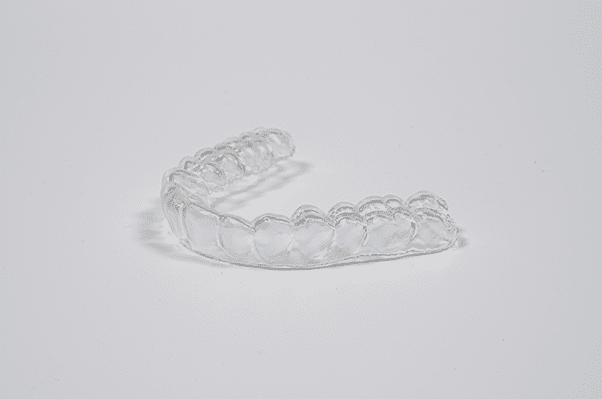3D printing dentistry solutions make it easier to produce custom products like dental prosthetics, implants, and surgical equipment such as guides. Surgical guides are becoming a standard tool to assist implant procedures, reduce surgery duration, and reduce the risk of complications. With advanced 3D printing systems, dental surgical guides are more affordable and accurate than ones made with traditional processes.

Traditional Production vs. 3D Printing for Dental Surgical Guide
Surgical guides aid in safe and efficient implant placement. Oral cavities are a restricted space, and implants must be placed accurately for a prosthetic’s success. The conventional thermoforming method for making surgical guides can’t account for soft tissue resiliency and bone topography. Traditional methods highly depend on the clinician’s skill and require more chair time for the patient.
3D-printed dental surgical guides are also customized to fit a patient’s mouth and have higher accuracy. As a result, implants are placed precisely with high geometric accuracy. Procedures are shorter, less invasive, and provide a less stressful experience for clinicians and patients.

Thermoforming
The traditional thermoforming process for producing surgical guides involves multiple steps to customize the guide to the patient’s mouth. The process begins with a dental impression or intraoral digital scan. A technician makes alginate/polyvinyl siloxane mold from the dental impression. Alternatively, the oral scan of the patient’s mouth provides the data for making a 3D-printed model.
The technician heats and thermoforms a thermoplastic sheet over the cast or 3D-printed model, cuts it, and then polishes. Sleeves are also placed in the surgical guide to strengthen the guide hole, ensuring surgical instruments and implants direct to the proper location.
Practices often outsource surgical guides to a lab and finish them in the office before surgery. Although thermoforming is still common for many dental products, it is time-consuming, labor-intensive, and expensive. Directly 3D printing surgical guides is an efficient, faster, and more accurate alternative solution.
Directly 3D Printing
3D printing solutions that combine dental-specific software, hardware, and resins provide a faster and more efficient alternative to thermoforming dental surgical guides. The practitioner simply sends a CAD file of the surgical guide to their 3D printer, which produces it using high-performance production resins. Production 3D printing systems tailored for dental practices streamline surgical guides’ production by minimizing the grinding and buffing post-processing steps. Increasing speed and quality, production 3D printing systems maximize lab productivity.
The Benefits of Directly 3D Printing Your Dental Surgical Guide
3D printing production systems give practitioners three main benefits toward greater patient comfort and reduced risk of complications:
#1 Rapid Turnaround
3D printing is a faster production process than traditional thermoforming, which also includes grinding and polishing. Practitioners can deploy current 3D printing solutions onsite to directly print a surgical guide from a digital 3D model of the patient’s mouth with little post-processing— eliminating outsourcing for fabrication.
With faster turnaround time and production efficiency, 3D printing service providers and dental labs can also benefit from 3D printing production systems tailored for surgical guide production. Dental labs receive a digital 3D model from the orthodontist, directly print and prepare the surgical guide, and send it back to the orthodontist’s office in a fraction of the time of traditional labs and with higher accuracy.

#2 Higher Accuracy
3D-printed dental surgical guides based on the patient’s teeth intraoral scan have a more accurate and comfortable fit to a patient’s mouth than guides produced with the impressions in the traditional thermoforming process. The resulting surgery and implantation procedure is stable and has a dependable success rate. Direct 3D printing of surgical guides based on 3D intraoral scan eliminates the need to make adjustments and enables same-day procedures.
The metal bushing used in a surgical guide requires accurate placement to ensure the correct results. With 3D printing, the bushing hole can be 3D-printed directly and with precision, post-print drilling to ensure fit. The guide also fits the patient’s mouth closely without repeated grinding and adjustment to ensure a secure fit.
#3 Digitized End-to-End Process for Better Customer Experience
As more dental procedures become digitized, dental appliance production is following suit. 3D printing naturally fits into digital dentistry by providing an on-demand digital production process for high-quality surgical guides. Dental offices can leverage existing intraoral scanning technologies and use 3D printing to produce higher quality products than traditional processes. The reduced manufacturing time, reduced costs, and more accurate surgical guides lead to better outcomes for patients.
Getting Started with 3D Printed Surgical Guides
Practitioners that want to use 3D printed dental surgical guides for their patients have two options available:
- Bring a dental 3D printing system in-house and produce surgical guides onsite.
- Use an on-demand 3D printing service bureau or lab and ship guides to the office.
An in-house system provides a fast and reliable method for fabricating high-quality surgical guides and other dental products. For an alternative to on-demand surgical guides, practitioners can use a 3D printing service provider or lab.
You can bring 3D printed dental surgical guide production in-office with LuxCreo’s 3D printing solutions. The LuxaDent system is ideal for smaller offices that want to 3D print surgical guides in-house, and the Lux 3 system is optimal for higher volume services providers, labs, or dental offices. As an FDA-approved 3D printing solution for night guards and retainers, LuxCreo can help you transform your dental business.
To learn more about our processes and services for producing 3D-printed dental surgical guides at scale, visit our contact page or call (650) 336-0888.
